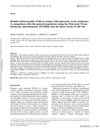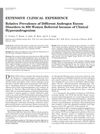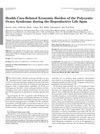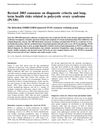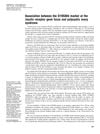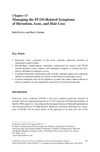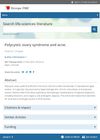Polycystic Ovary Syndrome: Comprehensive Overview and Diagnostic Criteria
August 2007
in “
The Lancet
”
Polycystic Ovary Syndrome PCOS androgen secretion insulin activity menstrual dysfunction infertility hirsutism acne obesity metabolic syndrome testosterone steroidogenesis hyperandrogenism chronic anovulation polycystic ovaries ultrasonography weight management oral contraceptives laser electrolysis topical minoxidil clomifene gonadotropins metformin insulin resistance ultrasound birth control pills laser hair removal Rogaine Clomid Glucophage
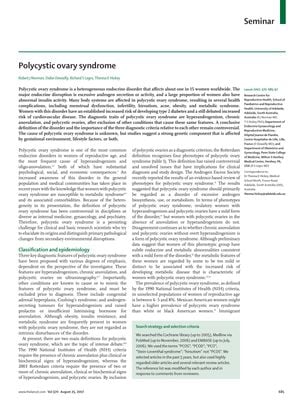
TLDR PCOS is a complex condition with major health impacts, needing more research for better diagnosis and treatment.
The document from 2007 provides a comprehensive overview of Polycystic Ovary Syndrome (PCOS), a common endocrine disorder affecting about 1 in 15 women worldwide. It is characterized by excessive androgen secretion or activity, often with abnormal insulin activity, leading to health complications such as menstrual dysfunction, infertility, hirsutism, acne, obesity, and metabolic syndrome. The etiology of PCOS is unknown but is thought to have a strong genetic component, influenced by environmental and lifestyle factors. The document discusses the controversy over the definition and diagnostic criteria of PCOS, with the 1990 NIH criteria and the 2003 Rotterdam criteria being the most used, the latter recognizing four phenotypes of PCOS. It also notes that 60-80% of women with PCOS have high testosterone levels and that the disorder may originate from uncontrolled steroidogenesis. The prevalence of PCOS varies by ethnicity and is higher in certain populations. Diagnosis involves assessing hyperandrogenism, chronic anovulation, and polycystic ovaries on ultrasonography. The document emphasizes the importance of weight management in improving reproductive and metabolic outcomes, and discusses various treatments for PCOS-related symptoms, including oral contraceptives, laser electrolysis, topical minoxidil, clomifene, gonadotropins, and metformin. It also highlights the increased risk of pregnancy complications in women with PCOS and the potential for early intervention to prevent insulin resistance and PCOS features in at-risk populations. The document concludes that PCOS is a diverse and complex disorder with significant health and economic burdens, and calls for future research to develop evidence-based diagnostic and treatment criteria, and to understand the natural history, cause, long-term consequences, and prevention of the disorder. Specific numbers of participants in the studies mentioned are not provided in the summary.

